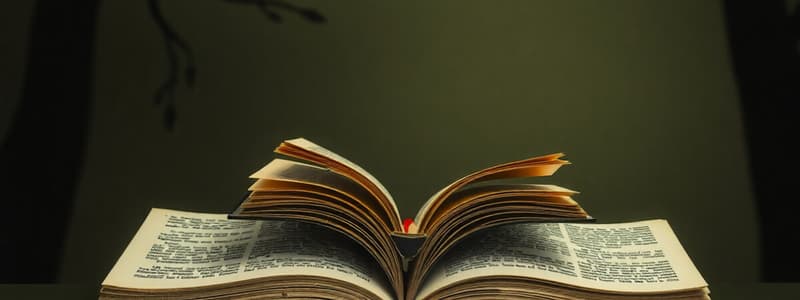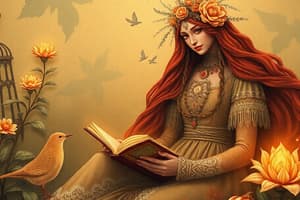Podcast
Questions and Answers
Which literary element primarily contributes to the emotional atmosphere of a story?
Which literary element primarily contributes to the emotional atmosphere of a story?
- Mood (correct)
- Setting
- Theme
- Plot
In a narrative, what is the central role of the 'theme'?
In a narrative, what is the central role of the 'theme'?
- To convey the main idea or hidden message. (correct)
- To establish the time and place.
- To outline the series of events.
- To describe the protagonist's physical appearance.
If a character is in conflict with their own desires and emotions, which type of conflict is being portrayed?
If a character is in conflict with their own desires and emotions, which type of conflict is being portrayed?
- Man vs. Man
- Man vs. Environment
- Man vs. Himself (correct)
- Man vs. Society
A narrative uses hints and clues suggesting an event that will occur later. Which literary devise is being used?
A narrative uses hints and clues suggesting an event that will occur later. Which literary devise is being used?
When events occur that are the opposite of what is expected, creating a sense of surprise, which literary device is being used?
When events occur that are the opposite of what is expected, creating a sense of surprise, which literary device is being used?
A character faces a difficult situation with only two possible outcomes, forcing them to make a critical decision. Which literary element is highlighted?
A character faces a difficult situation with only two possible outcomes, forcing them to make a critical decision. Which literary element is highlighted?
What distinguishes a 'dynamic character' from a 'static character'?
What distinguishes a 'dynamic character' from a 'static character'?
Which literary term refers to broad generalizations about a group of people, often based on unfair or untrue belifs?
Which literary term refers to broad generalizations about a group of people, often based on unfair or untrue belifs?
What characterizes a 'round character' in literature?
What characterizes a 'round character' in literature?
How would you describe a 'flat character'?
How would you describe a 'flat character'?
Which character is primarily responsible for driving the story forward and is most involved with the central conflict?
Which character is primarily responsible for driving the story forward and is most involved with the central conflict?
What role does the 'antagonist' play in a story?
What role does the 'antagonist' play in a story?
What is the significance of 'character traits' in a narrative?
What is the significance of 'character traits' in a narrative?
If a story is told using 'I' and 'me', which point of view is being used?
If a story is told using 'I' and 'me', which point of view is being used?
What is the primary characteristic of a narrative told from an 'omniscient' point of view?
What is the primary characteristic of a narrative told from an 'omniscient' point of view?
Which element of setting is most directly responsible for creating a sense of immediacy in a story?
Which element of setting is most directly responsible for creating a sense of immediacy in a story?
How does 'plot' primarily function in a narrative?
How does 'plot' primarily function in a narrative?
In 'Man vs. Environment' conflict, what does 'environment' represent?
In 'Man vs. Environment' conflict, what does 'environment' represent?
Which of the following is LEAST likely to be influenced by a story's setting?
Which of the following is LEAST likely to be influenced by a story's setting?
In a short story, a character consistently makes choices that reflect bravery, even when facing immense fear. Which literary element does this exemplify?
In a short story, a character consistently makes choices that reflect bravery, even when facing immense fear. Which literary element does this exemplify?
Flashcards
Setting
Setting
The time, place, and duration in which a story occurs, setting the stage for the narrative.
Mood
Mood
The feeling or overall atmosphere created in a story, influenced by the setting and the author's language.
Plot
Plot
The sequence of events that unfold in a story, showing cause and effect relationships.
Theme
Theme
Signup and view all the flashcards
Point of View
Point of View
Signup and view all the flashcards
First Person
First Person
Signup and view all the flashcards
Third Person
Third Person
Signup and view all the flashcards
Omniscient
Omniscient
Signup and view all the flashcards
Conflict
Conflict
Signup and view all the flashcards
Man vs Man
Man vs Man
Signup and view all the flashcards
Man vs Environment
Man vs Environment
Signup and view all the flashcards
Man vs Himself
Man vs Himself
Signup and view all the flashcards
Foreshadowing
Foreshadowing
Signup and view all the flashcards
Irony
Irony
Signup and view all the flashcards
Dilemma
Dilemma
Signup and view all the flashcards
Dynamic Character
Dynamic Character
Signup and view all the flashcards
Static Character
Static Character
Signup and view all the flashcards
Stereotype
Stereotype
Signup and view all the flashcards
Round Character
Round Character
Signup and view all the flashcards
Flat Character
Flat Character
Signup and view all the flashcards
Study Notes
- Literary terms are elements used in short stories
Setting
- Includes the time, place and duration of events
- Allows the reader to picture the scene in their mind
- Improves the overall atmosphere and mood
Mood
- Represents the feeling or overall atmosphere of the story
- It is dependent on the setting
- Language used by the author impacts the mood
Plot
- It is a series of events that unfolds in the story
- Explains how one event leads to another
Theme
- The theme is the main idea or hidden message
- Central element the story revolves around
Point of View
- The perspective from which a story is told
- Determines who is telling the story
- First person uses "I" and "me"
- Third person uses "he, him, they, their"
- Omniscient is a narrative perspective where the narrator knows everything
Conflict
- The struggle the protagonist goes through
- Clash between opposing forces
- Man vs Man: characters are against each other
- Man vs Environment: A character struggles against the forces of nature or their environment
- Man vs Himself: A character deals with internal conflicts, desires, emotions, and thoughts
Foreshadowing
- An element that hints at something to come later in the story
Irony
- Occurs when events or words convey the opposite of what is expected
- Creates a sense of surprise
Dilemma
- A conflict, problem, or situation with two possible outcomes
- A character is forced to make a decision
Dynamic Character
- Character that changes and evolves throughout the story
- Undergoes significant change and development
Static Character
- Remains the same throughout the story
- Personality, beliefs, and characterization stay consistent
Stereotype
- Concrete generalizations, often based on unfair or untrue beliefs
- Stereotypes can change over time
Round Character
- Complex personality, multidimensional
- Has distinct qualities and motives
Flat Character
- Relatively uncomplicated
- Does not change and lacks depth
Protagonist
- The main character in a story who drives the plot forward
- Most involved with the central conflict
Antagonist
- A character or force that opposes the protagonist
- Creates conflict and tension, often seen as the "bad guy"
Character Traits
- Describe how a person thinks, feels, and behaves
- Define a person's personality
Studying That Suits You
Use AI to generate personalized quizzes and flashcards to suit your learning preferences.




